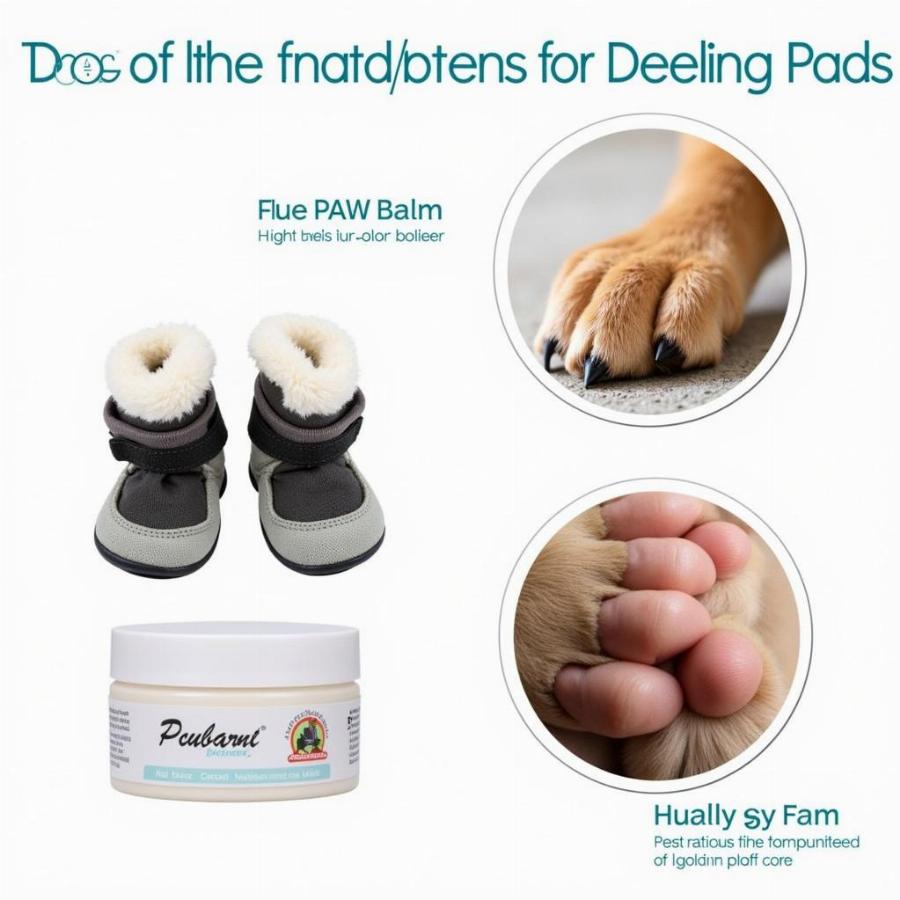Dog foot pad peeling off can be alarming for any pet owner. It can range from minor dryness and flaking to more serious cracking and bleeding. Understanding the underlying causes, treatment options, and preventative measures is crucial for ensuring your canine companion’s paw health and overall well-being. This article will delve into the common reasons behind peeling foot pads in dogs, effective treatment strategies, and practical tips to prevent this issue from occurring in the first place.
Why Are My Dog’s Foot Pads Peeling?
Several factors can contribute to dog foot pad peeling off. Identifying the root cause is essential for effective treatment. Some of the most common culprits include:
- Allergies: Just like humans, dogs can suffer from allergies to environmental factors like pollen, dust mites, and certain foods. These allergies can manifest in various ways, including itchy and peeling foot pads.
- Environmental Factors: Exposure to hot pavement, rough surfaces, ice, snow, and chemical irritants like de-icing salts can damage the delicate skin of your dog’s paws, leading to peeling and cracking.
- Infections: Bacterial, fungal, and parasitic infections can also affect a dog’s foot pads, causing inflammation, itching, and peeling.
- Nutritional Deficiencies: A lack of essential fatty acids and other nutrients in a dog’s diet can contribute to dry, flaky skin, including on their paws.
- Autoimmune Diseases: In some cases, peeling foot pads can be a symptom of an underlying autoimmune disorder, where the body’s immune system attacks healthy tissues.
- Hyperkeratosis: This condition causes excessive thickening of the outer layer of skin, leading to dry, cracked, and peeling foot pads.
Treatment for Peeling Dog Foot Pads
The appropriate treatment for peeling foot pads depends on the underlying cause. Consulting with a veterinarian is crucial for accurate diagnosis and treatment recommendations. Some common treatment approaches include:
- Addressing Allergies: Identifying and eliminating allergens from your dog’s environment, such as switching to hypoallergenic food or using air purifiers, can significantly alleviate allergy-related paw issues.
- Topical Medications: Your veterinarian may prescribe medicated creams, ointments, or soaks to treat infections or soothe irritated skin.
- Oral Medications: For severe cases of allergies or infections, oral medications like antihistamines, antibiotics, or antifungals may be necessary.
- Nutritional Supplements: Adding supplements rich in omega-3 fatty acids to your dog’s diet can help improve skin health and reduce peeling.
- Foot Soaks: Soaking your dog’s paws in warm water with Epsom salts can help soften dry skin and reduce inflammation.
Preventing Dog Foot Pad Peeling
Taking proactive steps to protect your dog’s paws can help prevent peeling and other related issues. Here are some effective preventative measures:
- Paw Balm: Regularly applying a protective paw balm can create a barrier against harsh environmental conditions and prevent dryness.
- Booties: Using dog booties can shield your dog’s paws from hot pavement, rough terrain, ice, snow, and chemical irritants.
- Regular Paw Checks: Inspect your dog’s paws regularly for any signs of dryness, cracking, or injury.
- Proper Hygiene: Keeping your dog’s paws clean and dry can help prevent infections.
- Balanced Diet: Providing a balanced and nutritious diet is essential for maintaining healthy skin and coat, including the paw pads.
Frequently Asked Questions about Peeling Dog Foot Pads
- Is dog foot pad peeling off a serious problem? While minor peeling can be harmless, excessive peeling, cracking, or bleeding can indicate a more serious underlying issue.
- When should I take my dog to the vet for peeling foot pads? If the peeling is severe, accompanied by other symptoms like limping or excessive licking, or doesn’t improve with home care, consult a veterinarian.
- Can I use human lotion on my dog’s paws? It’s best to avoid using human lotions, as they may contain ingredients that are harmful to dogs. Use a paw balm specifically formulated for canines.
 Ngăn ngừa bong tróc chân chó
Ngăn ngừa bong tróc chân chó
Conclusion
Dog foot pad peeling off can be a sign of various underlying issues, ranging from environmental irritants to allergies and infections. Understanding the causes, treatment options, and preventative measures can help you keep your furry friend’s paws healthy and happy. Remember, if you’re concerned about your dog’s paw health, consult with a veterinarian for proper diagnosis and treatment recommendations.
Beaut Dogs is your one-stop resource for all things related to dog care. We offer expert advice and valuable information to help you provide the best possible care for your beloved canine companion. For personalized support and detailed guidance, contact us at Email: [email protected]. Beaut Dogs is committed to helping you navigate the wonderful world of dog ownership.